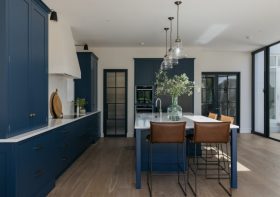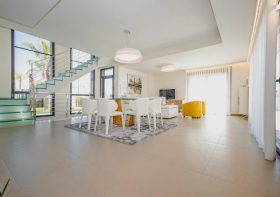Mid century sandstone exterior

At the heart of mid-century architecture is a commitment to simplicity, functionality, and a harmonious integration with nature. Sandstone, with its warm, earthy tones, emerged as a preferred choice for exteriors during this period. Its natural texture and color variations added character to buildings, while its durability made it a practical choice for both residential and commercial structures.
One of the defining characteristics of mid-century sandstone exteriors is the marriage of form and function. The clean lines and minimalistic designs typical of this era find perfect expression in the use of sandstone. Whether in the creation of geometric facades or the incorporation of large windows that blur the boundaries between indoors and outdoors, the sandstone exterior plays a pivotal role in realizing the mid-century vision.
The warm hues of sandstone resonate with the earthy palette often associated with mid-century interiors and exteriors. From golden yellows to rich browns, these colors create a welcoming and organic feel. The material’s ability to absorb and reflect sunlight also contributes to a dynamic interplay of light and shadow, enhancing the visual appeal of mid-century structures.
A prime example of mid-century sandstone architecture is the iconic Kaufmann House in Palm Springs, designed by architect Richard Neutra in 1946. The house features a sandstone exterior that complements the surrounding desert landscape. Its horizontal lines and large glass walls exemplify the mid-century emphasis on open spaces and a seamless connection with nature.
Beyond aesthetics, the use of sandstone in mid-century architecture reflects a commitment to sustainability. The material’s longevity and resistance to weathering make it a responsible choice, aligning with the era’s growing awareness of environmental considerations. The durability of sandstone also ensures that these mid-century gems endure, standing as testaments to a design ethos that continues to influence contemporary architecture.
In the realm of residential architecture, mid-century sandstone exteriors often find expression in single-story ranch-style homes. These structures feature low-pitched roofs, large windows, and expansive, open floor plans – all elements that showcase the simplicity and functionality inherent in mid-century design. The sandstone exterior becomes a key component, grounding the house in its natural surroundings while simultaneously exuding timeless elegance.
Commercial buildings of the mid-century era also embraced the charm of sandstone exteriors. From office complexes to educational institutions, the material was employed to convey a sense of solidity and permanence. The juxtaposition of sleek glass elements with the textured warmth of sandstone created a visually striking effect, capturing the essence of mid-century modernism.
As mid-century architecture experiences a resurgence in popularity, contemporary designers and homeowners are rediscovering the timeless appeal of sandstone exteriors. The material’s ability to seamlessly bridge the gap between past and present makes it a versatile choice for those seeking to evoke the spirit of mid-century design while embracing modern sensibilities.
In conclusion, mid-century sandstone exteriors embody the essence of an era marked by innovation, simplicity, and a profound connection to nature. The material’s warm tones, natural textures, and enduring qualities contribute to the timeless allure of mid-century architecture. Whether in residential dwellings or commercial structures, the use of sandstone during this period continues to leave an indelible mark on the built environment, inviting us to appreciate and reinterpret the design principles of a bygone era.




Leave a Reply